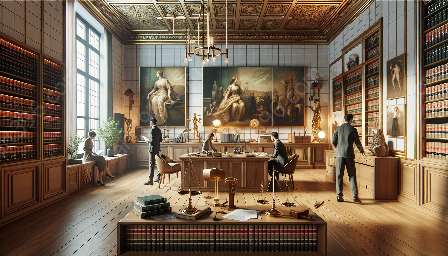Art display is an essential form of freedom of expression, but it also intersects with legal considerations within art galleries and museums. This article delves into the boundaries and laws governing art galleries and museums as well as the broader context of art law.
The Intersection of Freedom of Expression and Art Display
Freedom of expression is a fundamental right that allows individuals to articulate their thoughts and ideas through various mediums, including art. Artistic expression often challenges societal norms, political views, religious beliefs, and other controversial topics, making it a powerful vehicle for advancing discourse and change.
Art galleries and museums serve as platforms for artists to showcase their works, providing a space for the public to engage with diverse perspectives and interpretations. As such, they play a crucial role in upholding and promoting freedom of expression within the art community.
Legal Considerations in Art Galleries and Museums
While freedom of expression is highly valued, it is not without limits. Art display in galleries and museums must navigate legal boundaries to ensure compliance with relevant laws and regulations. Several legal considerations come into play:
- Censorship: Artistic expression may collide with societal sensitivities or offend certain groups, leading to potential censorship attempts. Understanding the legal premises and exceptions for censorship is crucial in preserving artistic freedom.
- Intellectual Property Rights: Artworks are subject to copyright protections, and proper licensing and permissions are necessary for displaying or reproducing copyrighted works. Museums and galleries must adhere to intellectual property laws to avoid legal disputes.
- Public Display Regulations: Local ordinances and zoning laws may dictate how art can be displayed in public spaces, including galleries and museums. Compliance with these regulations is essential to avoid legal repercussions.
- Social Justice and Equality: Artistic expression can confront issues of social justice, equality, and human rights. Understanding the legal frameworks surrounding these sensitive topics is crucial for mitigating legal risks.
Art Law: Navigating Legal Boundaries
Art law encompasses a broad range of legal issues concerning the creation, display, sale, and preservation of art. It intertwines with freedom of expression, copyright law, cultural property, and other legal domains specific to the art world.
Key aspects of art law that are pertinent to art display in galleries and museums include:
- Contracts and Transactions: Art dealers, collectors, and institutions engage in transactions involving artworks, necessitating legally binding contracts to govern ownership, display rights, and sales.
- Authentication and Forgery: Legal disputes concerning the authenticity of artworks and instances of forgery are common in the art market. Establishing legal frameworks for authenticating artworks and addressing forgeries is essential.
- Art Repatriation and Cultural Heritage: Issues of cultural heritage, repatriation of artworks, and looted art involve complex legal considerations, requiring adherence to international conventions and laws.
- Freedom of Speech Protections: Artists and art institutions may face legal challenges related to freedom of speech, particularly in controversial exhibitions. Understanding the scope of free speech protections is critical.
Conclusion
Freedom of expression in art display is a multifaceted concept that necessitates a nuanced understanding of legal frameworks. Art galleries and museums act as vital platforms for fostering diverse artistic voices while navigating the legal intricacies that govern art display. By comprehensively comprehending the intersection of freedom of expression, art display, and art law, stakeholders within the art community can uphold artistic freedoms while respecting legal boundaries.

